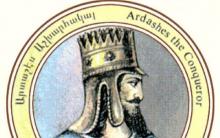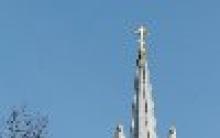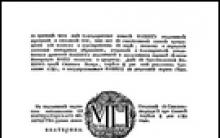I was once asked to come up with a riddle in verse about a goose for a children’s party, and the pinnacle of my creativity was “I scream ha-ha-ha, with webbed feet.”
But before we start drawing, a couple of announcements.
Thirdly, a book will be released soon, interesting and exciting, Remy Oren is smoking nervously in the corner, stay tuned.
Fourthly, now you can support our project financially without spending money. If you are planning to buy something on Ozone, go to Ozone using a link from our website (“showcase” at the bottom in the right column), and a small percentage of the amount of your purchase will drop into our account. Of course, it’s a small thing, but it’s still nice.
Well, that's all the news, now grab your easels and brushes!
Let's start drawing a goose with a squiggle like this, it will be the beak from the front, i.e. front. By the way, many people say “full face”, which is incorrect: the correct word is “full face”, without the “in”. Please note: the tips are slightly curved upward. If you want a sad goose, turn them down.

And along the beak there is a smile. My right tip didn’t quite reach the edge, it’s better to bring it closer.

On top we draw the head (shaped like an egg) and eyes...

... and add a forelock:

Teeeks, now the neck. Such a long (but without fanaticism, this is not a boa!) goose neck. If you draw it as straight as a log, you will get a goose with a dull expression on its face, so the neck first narrows and then widens back:

We are done with the neck and are finishing the belly. It is similar in shape to ours:

Wings. In my drawing they are facing left-up and right-up (at about 10 and 2 o'clock), you position them as you wish. We draw an arc to the left and up...

...and we return back with such frilly waves:

Take two:

The wings turned out to be quite thin, you can draw them wide, he still has time to fly south.
Paws. Slightly sloping “glasses” to the side (if you draw them vertically, it will look like the goose is either standing on tiptoes or dangling in the air).
How to easily draw a goose with a pencil step by step for children and adults. Let's learn to draw a beautiful goose with a pencil step by step together with your child. Find out how to quickly and easily learn to draw a beautiful goose.
Every person in his life wants to learn how to draw beautifully and quickly, children especially love to draw and want to learn how to draw beautifully, they are interested in learning to draw not only nature, the sun, flowers, houses, people, but also pets and wild animals.
Today we’ll see how you can easily and quickly learn to draw one of the domestic animals, a goose. Take a sheet of paper and a pencil, look carefully at the picture where a goose is drawn. Look at the position of the goose, how and where its different body parts are located.
In the center of the picture is the body of a goose, on the right is the tail of the goose, on the left is the head of the goose, and at the bottom are the paws of the goose.
Now, in the same way, mentally, divide your sheet of paper for different parts goose body
First, start drawing the goose from the body, draw the body of the goose in the form of a large oval, the right part of the oval is lower, and the left part of the body is located above. A little above the body on the left side, draw the head of the goose, in the form of a small circle. Connect the head and body with two smooth lines - this will be the neck of the goose.

Draw the goose's eye in the center of the head. On the left side draw the beak of a goose, it looks a little like two triangles, the tips of the beak are sharp.

Now draw the goose’s wing, it should be large, the end of the wing should be pointed. At the bottom, draw the legs of the goose. The goose's legs are short; draw spurs on the back of the goose.

Finish drawing the goose’s wing, draw its feathers, long and beautiful.

Look how beautiful your goose is. Paint the goose with any colors or leave it white, whatever you like.
Let's try to draw another goose

Take a sheet of paper and a pencil, look carefully at the picture where a goose is drawn. Look at the position of the goose, how and where its different body parts are located.
In the center of the picture is the body of a goose, on the right is the tail of the goose, on the left is the head of the goose, and at the bottom are the paws of the goose. Now, in the same way, mentally, divide your sheet of paper for different parts of the goose’s body.
First start drawing the goose from the head, draw the goose's head like a jagged square.
At the top of the head, draw the goose's eye in the form of a small oval and fill in the pupil. On the left side, draw the beak of a goose; the nose should be small, elongated, and the tip sharp.

On the right side of the head, draw two curved lines downwards - this will be the neck of the goose.

Now you need to outline the outline of the goose’s body, draw it approximately, like an irregular rectangle, sketch the tail on the right side.

Outline the outline of the goose with smooth lines, draw a tail and the outline of the legs.

Draw the back of the goose's legs, draw spurs and draw wings and feathers.

Erase the extra lines that are no longer needed, draw a brighter outline of the goose.
Apply a small stroke all over the goose.

Look what a beautiful goose you have made. Color the goose as shown in the top picture or with any colors you like.
Courses for the development of intelligence
We also have interesting courses, which will perfectly pump up your brain and improve intelligence, memory, thinking, concentration:
Development of memory and attention in a child 5-10 years old
The course includes 30 lessons with useful tips and exercises for children's development. In every lesson helpful advice, several interesting exercises, an assignment for the lesson and an additional bonus at the end: an educational mini-game from our partner. Course duration: 30 days. The course is useful not only for children, but also for their parents.
Secrets of brain fitness, training memory, attention, thinking, counting
If you want to speed up your brain, improve its functioning, boost your memory, attention, concentration, develop more creativity, perform exciting exercises, train in game form and solve interesting problems, then sign up! 30 days of powerful brain fitness are guaranteed to you:)

Super memory in 30 days
As soon as you sign up for this course, you will begin a powerful 30-day training in the development of super-memory and brain pumping.
Within 30 days after subscribing, you will receive interesting exercises and educational games in your email that you can apply in your life.
We will learn to remember everything that may be required in work or personal life: learn to remember texts, sequences of words, numbers, images, events that happened during the day, week, month and even road maps.

Money and the Millionaire Mindset
Why are there problems with money? In this course we will answer this question in detail, look deep into the problem, and consider our relationship with money from psychological, economic and emotional points of view. From the course you will learn what you need to do to solve all your financial problems, start saving money and invest it in the future.

Speed reading in 30 days
Would you like to quickly read books, articles, newsletters, etc. that interest you? If your answer is “yes,” then our course will help you develop speed reading and synchronize both hemispheres of the brain.
When synchronized, working together both hemispheres, the brain begins to work many times faster, which opens up much more possibilities. Attention, concentration, speed of perception intensifies many times over! Using the speed reading techniques from our course, you can kill two birds with one stone:
- Learn to read very quickly
- Improve attention and concentration, as they are extremely important when reading quickly
- Read a book a day and finish your work faster
We speed up mental arithmetic, NOT mental arithmetic
Secret and popular techniques and life hacks, suitable even for a child. From the course you will not only learn dozens of techniques for simplified and quick multiplication, addition, multiplication, division, and calculating percentages, but you will also practice them in special tasks and educational games! Mental arithmetic also requires a lot of attention and concentration, which are actively trained when solving interesting problems.

Conclusion
Learn to draw yourself, teach your children to draw, to draw a goose step by step, it took you a little time, but now you know how to draw this magnificent domestic animal. We wish you good luck in your future works.
What are we going to do today? Let's draw a goose.
Our goose will be domestic. Children often say that geese are scary, but no matter how many times I visited the village, how many times I looked at the geese, I didn’t feel any fear at all, only curiosity. When they see a person, geese tend to approach with their necks stretched out and hissing. But you can’t fool us, and that’s not what we’ve seen. A twig can put any bully to flight.
But we were going to figure out not how to fight back, but how to draw a goose.
Let's start with the simplest picture: a goose is standing. We have a great photo - it will serve as a cheat sheet for us. First, let's make a pencil sketch.
Unlike a duck, a standing goose is rather tall than wide, so let's place the sheet vertically. The body of the bird is large and massive. Moreover, in a standing goose it is not located completely horizontally, but rather at a slight angle.

The back is slightly arched - the folded wings are slightly hunched. The chest with goiter and belly are convex, and the belly actually sags. The neck is long, powerful at the base, slightly curved, tapering towards the head.
 The head of a goose is relatively small, and the beak of some breeds with a growth at the base is narrow and elongated.
The head of a goose is relatively small, and the beak of some breeds with a growth at the base is narrow and elongated.

The legs of a standing goose are shifted closer to the back of the body; they are quite short, with large, strong toes. The wings are folded on the back in the same way as, for example, a person folds his arms behind his back. The tail is not clearly expressed. Let's look at the goose with its head held high. In this picture, the junction of the neck and torso clearly stands out, pay attention to this detail. By the way: don’t get me wrong, but I really wouldn’t want to instill in students such expressions as “the head and neck are connected.” You cannot do without them completely, but they should be avoided in every possible way. A goose is a goose, it does not “consist” of body parts. We call parts of the body by their names (wing, leg, eye, head) FOR CONVENIENCE, if you take a goose as a goose, as a whole living bird, then there are no body parts. After all, understand, no one connects them like parts of a machine (these are parts in the literal sense). So deal with the goose without taking it apart into its component parts.

This goose is white. But we will give it some volume and life-like appearance by adding shadows:

We have also prepared for you images of a goose with different neck positions. The bird's neck can bend very bizarrely, at a fairly large angle. I would not like to give these bends any names.
We start drawing, as usual, with a pencil sketch.
 Now overall plan The future picture is clear and we begin to draw the body of the goose:
Now overall plan The future picture is clear and we begin to draw the body of the goose:
 And here is our drawing - a goose is walking on the ground.
And here is our drawing - a goose is walking on the ground.
 In this picture the bird is walking, slowly moving its legs, in the next one our goose is running.
In this picture the bird is walking, slowly moving its legs, in the next one our goose is running.
This lesson fell into the category of easy ones, which means that in theory it can be repeated by Small child. Naturally, parents can help young children draw a goose. And if you consider yourself a more advanced artist, then I can recommend the “” lesson - it will require more perseverance from you, although it will be no less interesting.
What you will need
In order to draw a goose we may need:
- Paper. It is better to take medium-grain special paper: beginning artists will find it much more pleasant to draw on this kind of paper.
- Sharpened pencils. I advise you to take several degrees of hardness, each should be used for different purposes.
- Eraser.
- Stick for rubbing hatching. You can use plain paper rolled into a cone. It will be easy for her to rub the shading, turning it into a monotonous color.
- A little patience.
- Good mood.
Step by step lesson
Each bird is not only unique in coloring, but also has its own anatomical structure. To draw a goose correctly, you need to be present in person, if possible. Yes, I'm talking about drawing from life. I understand that this is very difficult to do, but it will give you a big head start. I can also advise you not to neglect photo cards on the Internet.
By the way, in addition to this lesson, I advise you to pay attention to the lesson “”. It will help improve your skill or just give you a little fun.
Simple drawings are created using contours. It will be enough for you to repeat what, and only what is shown in the lesson, to get an acceptable result, but if you want to achieve something more, then try to present that. what do you draw in the form of simple geometric bodies. Try making a sketch not with contours, but with rectangles, triangles and circles. After some time, with constant use of this technology, you will see that drawing becomes easier.
Tip: create a sketch with as thin strokes as possible. The thicker the sketch strokes are, the more difficult it will be to erase them later.
The first step, or rather the zero step, is always to mark a sheet of paper. This will let you know where exactly the drawing will be located. If you place the drawing on half of the sheet, you can use the other half for another drawing. Here is an example of marking a sheet in the center:
Step one. First, draw two circles, large and small, and connect them with a curve.

Step two. In accordance with the circles, draw the body, long neck, beak and eyes.

Step three. We remove the extra lines from the first circles, outline the body itself in bold, draw the paws and under them.

Step four. All that remains is to carefully draw the main attribute of the bird - the plumage. You can add shading.

I sincerely hope that you enjoyed the lesson on how to draw a goose. If you put in the effort, I believe you will achieve everything you set your mind to. Now you can pay attention to the lesson “” - it is just as interesting and exciting. Share the lesson on in social networks and show your results to your friends.
To draw a goose, we use a simple pencil of medium hardness (HB), STABILO CarbOthello colored pastel, drawing paper and tinted paper for drawing with pastels. The image of the goose is done in stages. We start by making a drawing diagram on drawing paper, drawing out the details of the goose. Then we transfer the drawing onto tinted paper and work on it with pastel pencils.
On drawing paper with a simple pencil draw an oval. Through it down we draw a wavy line of the neck and middle of the body.

On the line closer to the bottom, draw a larger oval - this will be the body with a wing. From the large oval downwards we draw two lines - the legs of the goose.
In the upper oval we draw lines for the thickening of the beak to the head and the eye.


Add a neck thickness line from the top oval to the bottom oval. In the oval of the wing we draw plumage lines. On the continuation of the line of the middle of the body, draw a tail with a triangle.


Draw the contours of the head and neck with smooth lines. Mark the wing feathers. Draw the feathers of the wing and tail.


Draw the legs of the goose. We draw the paws crosswise to the line of the legs in triangles with membranes. We transfer the drawing onto tinted paper. Why do we shade the back side of the paper sheet with the pattern. We apply it with the shaded side to a sheet of tinted paper and, tracing the outline of the drawing, transfer the image to the tinted sheet. Cover with light strokes using a pastel pencil. white plumage. Using brown color we go over the edge of the wing and the tail. Orange - beak and legs. Use a special shading or just a finger to shade the shaded part.


Add a layer of shading with pastel pencils. Increasing the saturation of the color tone downwards brown. Lightly blend.

Pastel pencil Brown draw top edge plumage. Shade it a little. Using a pastel pencil of black flowers, draw the outline of the plumage of the wing and tail. Bright orange select the beak and paws. White emphasizes the contrast of plumage color. The drawing is ready. We fix it with fixative or hairspray.











How to properly and tasty cook pancakes with cottage cheese
Rose petal jam made by me
Buckwheat with pork ribs in a slow cooker Ribs with buckwheat in a slow cooker recipes
Chicken skewers Chicken skewers with bacon
Mushroom glade salad with honey mushrooms recipe with photos How to prepare mushroom glade salad with honey mushrooms